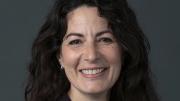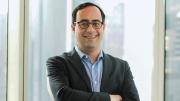Following last semester’s convulsive Israel-Palestine protests, Harvard has intensified its interest in fostering open, respectful dialogue on campus. In the past few months, the Kennedy School published a report on constructive conversations, Harvard sponsored a week of events about civil discourse, and the College publicly launched the Intellectual Vitality Initiative.
But the idea of fostering healthy disagreement on campus is not new. In 2018, after a series of hateful incidents on American University’s campus, Lara Schwartz, J.D. ’98, who was then a lecturer on public affairs, founded and now directs American’s Project on Civic Dialogue. For the last six years, alongside teaching government classes, she has helped train AU students to constructively engage with their peers. Her new book, Try to Love the Questions: From Debate to Dialogue in Classrooms and Life (Princeton University Press), provides insights that might help Harvard improve its campus speech climate.
Schwartz believes it is important for all participants in campus discourse to understand the rules. Her book explains the First Amendment in lay terms and notes legal exceptions to free speech (some of which apply to campus settings). But, she writes, “I often remind students that the First Amendment is only a limitation on government—not a blueprint for how to live.”
Just because the First Amendment allows you to say something does not mean you should. As a civil rights lawyer, Schwartz understands that hateful speech is often legal. But schools have community norms—unwritten guidelines that help determine what kinds of speech are considered acceptable. These unwritten norms can be jarring for incoming first-years, who are often acclimated to the stifled speech climate of their high schools. Robust campus speech programming (whether through orientation workshops, peer training sessions, or classes) can help students approach college-level dialogue with respect and care.
Encouraging Healthy Disagreement in Higher Education Debates
Higher education headlines often focus on inflammatory moments—controversial speakers, heated debates, and big protests—but Schwartz believes the most important speech to encourage and protect is dialogue, not debate. “Debate is not a truth-seeking mechanism: debate is a contest,” she said in an interview. “In a classroom, we have a goal…to understand, not to win.” Dialogue encompasses a much broader range of ideas than a yes-or-no debate. “If you’re an undergrad and you’re in a position of asserting and defending” a specific stance, she says, “you might have skipped multiple steps, because this is a time that we’re trying to learn.”
Her book guides professors toward building “dialogic classrooms.” Class, she writes, should be a place for “identifying, exploring, and attempting to answer challenging questions with integrity.” When teaching about specific issues, professors should pivot from yes-or-no debates to “under what circumstances.” For example, instead of assigning an essay on “Do you support mask mandates?” she suggests tweaking the prompt to “Under what circumstances may authorities require people to wear personal protective equipment?” Removing binaries and de-emphasizing existing political labels, she writes, lead to more robust discussions and allow students to consider a wide range of connected questions.
Within the classroom, Schwartz suggests turning positions into rules. Although students may disagree on specific policies, they may find common ground when they explain their reasoning. Supporting two different positions “means all disagreements are 100 percent disagreements,” she writes. But when articulating different rules (broad philosophies that guide specific positions), students can find more overlap and engage in meaningful disagreements.
Those respectful ways of engaging classroom disagreements fuel learning. She often thinks back to her Harvard Law School torts class. Her professor’s focus on law and economics “sounded really heartless to me,” she says. “I was so irritated with his approach that I worked 10 times as hard to understand it and rocked the final.” She learned so much in the class, she thinks, due to the “fire of my disagreement,” and credits the professor for stoking strong dialogue. “It’s really worth interrogating your disagreements and having to work hard across those disagreements,” Schwartz says now.
Today, fostering healthy disagreement is a primary focus of Schwartz’s Project on Civic Dialogue. Its most popular program, “Disagree with a Professor,” invites students to challenge professors outside the graded classroom setting so they can become comfortable initiating dialogue. Some recent topics of discourse include American University’s new policy limiting student expression, assisted suicide’s harm to civil rights, and Teach for America’s impact on teaching. In these sessions, professors solicit student comments and encourage disagreement. The program, Schwartz told The Washington Post, helps model how future leaders can “listen to one another, speak to one another, and solve our significant problems together.” The Project on Civil Dialogue also trains student dialogue facilitators, funds small grants for speech-related events, and soon hopes to establish a certificate program on dialogue. Events are optional, but some professors integrate peer dialogue leaders into their course curriculums.
Changing Administrative Promises Around Free Speech Culture
After its tumultuous autumn, Harvard administrators may be tempted to issue a slew of new rules to regulate campus protest. But Schwartz cautions against overregulating speech. Rules monitoring campus speech, she suggests, should be viewpoint-neutral and equally enforced. For example, a regulation against megaphones at night, she writes, should apply both to the marching band and a protest. But speech rules, even if well-intentioned, can end up stifling campus voices—regulations, she notes, have historically been used against civil rights activists.
Nor is punishment an answer to hate or misinformation, Schwartz maintains. Instead, she says, “Institutions can model bravery in sitting in uncertainty,” specifically by not adopting punitive approaches to speech: “If you believe that your students will benefit from knowing a multiplicity of views, then it’s not wise to ban political posters.”
Schwartz says that truly embracing dialogue will require college administrators to radically change the way they frame the college experience. “Our culture of promises and optimistic communication probably needs to change,” she says. “When you are a university president, and you say hate has no place here…students can be forgiven if they see this as an enforceable promise. And if you have a free speech commitment, it’s possible that hate is disliked and detested here but has to go unpunished.”
This spring at Harvard, many committees will assemble to build the future campus speech culture. From the Kennedy School to Massachusetts Hall, students and faculty will try to encourage respectful disagreement, disincentivize disruptive protest practices, and foster mutual respect. Schwartz’s work can guide these well-intentioned committees and community members from overregulation while articulating a path toward healthy classrooms and campus conversations.








